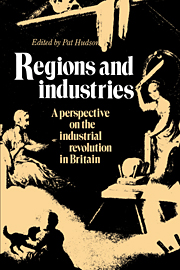Book contents
- Frontmatter
- Contents
- List of figures
- List of maps
- List of tables
- List of contributors
- Acknowledgements
- Introduction
- 1 The regional perspective
- PART ONE THE TEXTILE HEARTLANDS OF THE INDUSTRIAL REVOLUTION
- PART TWO OTHER PATHS, OTHER PATTERNS
- PART THREE THE DIVERSE NATURE OF THE OUTER REGIONS
- 8 Two paths to economic development: Wales and the northeast of England
- 9 Proto-industrialisation in Scotland
- 10 The environment and dynamic of pre-factory industry in Northern Ireland
- Index
8 - Two paths to economic development: Wales and the northeast of England
from PART THREE - THE DIVERSE NATURE OF THE OUTER REGIONS
Published online by Cambridge University Press: 05 May 2010
- Frontmatter
- Contents
- List of figures
- List of maps
- List of tables
- List of contributors
- Acknowledgements
- Introduction
- 1 The regional perspective
- PART ONE THE TEXTILE HEARTLANDS OF THE INDUSTRIAL REVOLUTION
- PART TWO OTHER PATHS, OTHER PATTERNS
- PART THREE THE DIVERSE NATURE OF THE OUTER REGIONS
- 8 Two paths to economic development: Wales and the northeast of England
- 9 Proto-industrialisation in Scotland
- 10 The environment and dynamic of pre-factory industry in Northern Ireland
- Index
Summary
The industrialisation of south Wales has always been puzzling. Historians have usually reached for a colonial analogy of some kind to explain it. The Hammonds started the trend by comparing the lack of an industrial tradition and social conditions in south Wales with an African goldfield. Closer observers of Welsh affairs have often agreed, and Perkin made a shrewd summary of their findings in 1969, concluding that the industrial process in south Wales had been semi-colonial.
Wales, with mineral resources and a similar but slightly more advanced society [i.e. than Ireland and the Scottish Highlands] is a still more interesting test case. There, handicapped in the early stages by lack of capital, lack of entrepreneurs and lack of a potential proletariat, industrialism had to be induced from outside. The result was a semi-colonial economy in which capital was provided in large blocks by English capitalists encouraged by favourable concessions from local mineral owners.
This train of thought led a careful scholar (in a playful mood) to wonder whether Wales had truly been industrialised; its late nineteenth-century economy was concentrated (and to an increasing extent) on the primary production of commodities, notably coal. Urbanisation lagged behind the average British level, manufacturing was of little importance and most work was of a handwork, almost craft variety. Central features of nineteenth-century industrialisation were missing, and perhaps the beast itself was.
Michael Hechter's book Internal Colonialism: The Celtic Fringe in British National Development 1536–1966 (1975) took this approach to its logical conclusion and extended it to the whole of Wales. For Hechter England had always been the core of British political and economic power and it had constantly dominated the Celtic periphery.
- Type
- Chapter
- Information
- Regions and IndustriesA Perspective on the Industrial Revolution in Britain, pp. 201 - 227Publisher: Cambridge University PressPrint publication year: 1989
- 2
- Cited by

